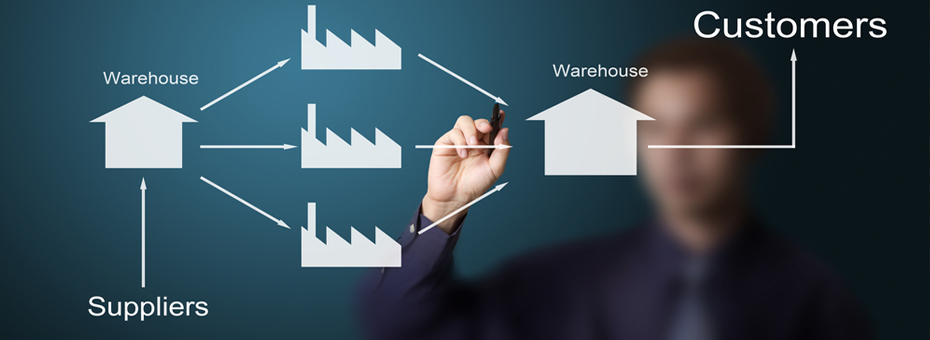Integrating suppliers (and customers for that matter) into your lean journey is simple. It’s simple because, quite simply, it’s about broadening the scope of your value stream.
That said – and here’s where it gets difficult – a member of your team needs to understand what a value stream entails, what value streams exist in your organization, and how to make a real value stream map. They will need to understand what a value stream map really is and how to use it. There are some great resources available that can help close the gap here including Learning to See (for the basics) and then Seeing the Whole. The latter gives you a macro view of value stream management.
Consider your typical 1000′ Map. In a manufacturing line or a factory, you have a core process with upstream and downstream processes…
Step 1 – The Ability to See
As your perspective broadens to a 5000’ level, your supply chain becomes the core process you’re looking at, and your suppliers and customers become the upstream and downstream processes. The connection between these processes will be the flow of material and information. These things should be depicted as they are in a normal value stream map. (I use blue for material and black for information). Once you have this mapped out it will quickly reveal where your opportunities lie. You’ll gain a better view by involving your partners during the map building process. If you don’t involve them at this step, they will need to become involved in the verification (check) portion of the map making process.
Step 2 – Looking Ahead
Using the current state map will help you identify waste opportunities. Developing a future state map will help provide a vision for both parties to align on. Understand that if you are going to take the future state step, then your supplier has to be a part of that process in order to prevent unrealistic goal setting. You’ll have plenty of opportunities where both participants are able to remove waste from the value stream and add value back to your organizations.
Step 3 – Sharing the Knowledge
To peel things back another layer, if your supplier doesn’t have their own improvement methodology in place, you might consider sharing your methodology. You may be surprised how open your supplier is to having a group of employees participate in kaizen events, attend lean classes, or even host a class at their site. This is another opportunity to improve alignment between organizations. Methodologies are much like languages. If your supplier is familiar with the just-in-time idea, then everyone is speaking the same language.
Step 4 – Using the Tools
Finally, shared kaizen events are another great way of integrating a value stream or integrating multiple value streams. Understand that these events have to be collaborative in nature. There also should be expressed value from both parties. As you continue to provide opportunities for learning, it will become more “normal” for both organizations to broaden their scope. This begins to happen more naturally. In time you may even find that collaboration becomes so integrated into the way you work that your supplier becomes a part of your long-term planning objectives.
What happens next? One day you wake up and find that you and your supplier are using an eight step problem solving process (A3) to resolve issues as you review the new, broader value stream map and are considering Bridge Plan actions you’ll need to take to move forward next year. (If you don’t have a Bridge Plan, then you have something like it; it’s a list of prioritized projects with expected completion dates and project champions). When posting current and future state maps, I like to post the Bridge Plan between them to help track how we aim to achieve our goals. If you’re unfamiliar with the A3 thinking proces, here’s a good example. And John Shook’s Managing to Learn is a great source for either someone new to the eight step process or an expert who wants to learn how to mentor others.
I can say these activities working with suppliers have been some of the most educational and exciting projects I have participated in. Educational because they have expanded my understanding of how my business really affects suppliers and customers. Understanding how to really work with suppliers brings a strength of relationship to your endeavors as you begin to get a better view of the whole value stream. You get to “take a stroll in their shoes” and gain a much better understanding of how and why they operate the way they do. The real excitement comes from seeing such potential for waste elimination; in almost every case there is potential for it and/or value creation on both sides. Plus, there is just the satisfaction of sharing your lean journey with a fellow traveler.





